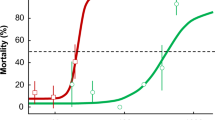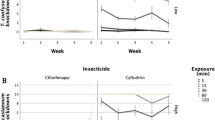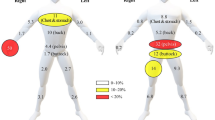Abstract
IN reply to the queries raised by Mr. Beckley, I should like to record that the experiments described in my original letter were carried out merely to compare the toxicity and persistence of pyrethrins and gamma benzene hexachloride under similar conditions. The dusted wheat was contained in 2-oz. glass jars covered with organdie muslin and packed closely together in a wooden tray, 2½ in. deep. The experiment was conducted in a constant-temperature room having a small window facing north-east. Consequently, only very weak, diffuse light reached the dust scattered among the wheat grains.
This is a preview of subscription content, access via your institution
Access options
Subscribe to this journal
Receive 51 print issues and online access
$199.00 per year
only $3.90 per issue
Buy this article
- Purchase on Springer Link
- Instant access to full article PDF
Prices may be subject to local taxes which are calculated during checkout
Similar content being viewed by others
Author information
Authors and Affiliations
Rights and permissions
About this article
Cite this article
BOVINGDON, H. Persistence of Pyrethrins and Gamma Isomer of Benzene Hexachloride. Nature 164, 458–459 (1949). https://doi.org/10.1038/164458c0
Issue Date:
DOI: https://doi.org/10.1038/164458c0
Comments
By submitting a comment you agree to abide by our Terms and Community Guidelines. If you find something abusive or that does not comply with our terms or guidelines please flag it as inappropriate.



